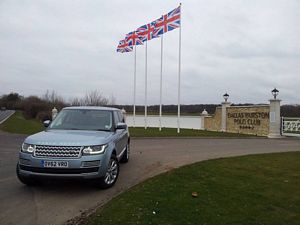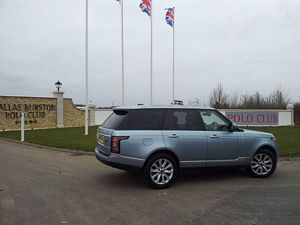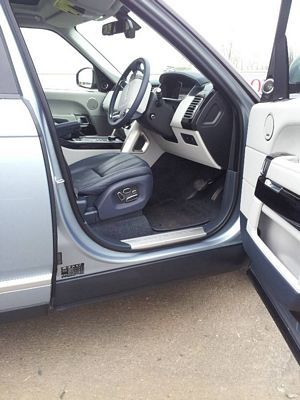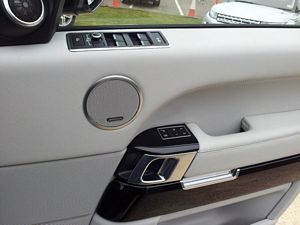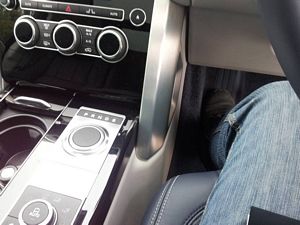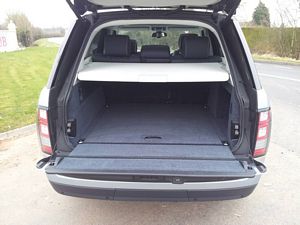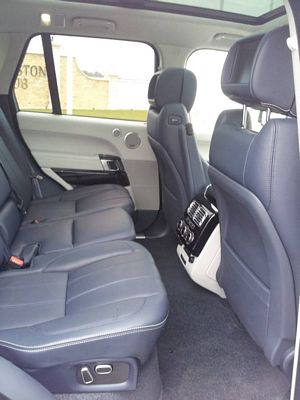|
By accessing or using The Crittenden Automotive Library™/CarsAndRacingStuff.com, you signify your agreement with the Terms of Use on our Legal Information page. Our Privacy Policy is also available there. |

Driven – new Range Rover TDV6
|
|---|
|
|
Driven – new Range Rover TDV6
Colin Hubbard
Speedmonkey
March 5, 2013
Colin Hubbard reviews the all new 2013 Range Rover TDV6.
The very first Range Rover was launched in 1970. Fast forward 43 years and the completely new Range Rover, codename L405, is rolling off the Land Rover production lines. Designed to be the ultimate 4 wheel drive car in terms of off-road endurance, on-road manners and taking luxury up a couple of notches to rival all of the premium brands including Rolls Royce and Bentley.
I will start this feature with a small history lesson on Range Rovers. The first Range Rover was called the Classic and was produced from 1970 to 1996, to deliver off road abilities to farmers and estate owners who wanted something nice to drive around their property in instead of rickety and uncomfortable old Land Rovers. It did rather well with its power steering, carpeted floors and coil spring suspension.
In 1994 the P38 was launched, with V8 petrol engines and, for the first time in a Range Rover, a diesel engine, air suspension and lots of electrical features that would go wrong in later years. This was discontinued in 2002, when the L322 model was launched under BMW ownership and designed to take luxury to new levels, along with more frugal diesel engines and, eventually, powerful Jaguar derived engines including a supercharged V8 with over 500 horsepower.
Every evolution of the Range Rover has been bigger and better than the previous version and also heavier than the outgoing model, with the exception of the current model. The L405 is some 420 kilos lighter than the previous model (that’s a whole cow) due to clever use of aluminium and modern engineering.
I drove the TDV6 variant with a 3 litre V6 diesel which puts out 256 horses and 443 torques - and was very surprised at the performance. The quoted figures are standstill to 60mph in 7.4 seconds and onto a top speed of 130 miles per hour. Pretty good for the base model with a diesel engine, and better acceleration than my Golf GTI. This is really moving things on.
The weight loss has helped performance and also economy - with a quoted combined 37.7 MPG but, as with all modern cars, I seriously doubt this figure. In this day and age this really is enough performance for something so huge and if that’s not enough speed there are three further engines to chose from.
There is another Diesel with a V8 engine (339 bhp) and two petrol engines, one naturally aspirated (375bhp) and one supercharged (503bhp). If I had a lottery win and money was not a restriction I would go for the V8 Diesel. This offers the right blend of effortless performance along with reasonable economy and fuel range as, whilst this is lighter than the old car, it still weighs in at a hefty 2160kgs. Which is about as much as 5 cows.
Once you have stepped up into the big beast and made yourself comfy in the wide, comfortable drivers chair you notice what a lofty driving position it is and why four wheel drive cars are so popular. They give you a feeling of opulence and you soon find yourself looking down on other cars like they are the lower classes.
The interior is a work of art and has intensified the luxury feel from the previous generation Range Rover with very high quality materials and feel of the switchgear. Space is more than ample in the front and rear, even the rear seats have electric adjustment so you can get just comfortable with little effort.
At this stage I’m thinking that if Bentley press on with their own SUV they will have a task to beat the new Range Rover.
The dash layout has been carefully thought out but with far too many buttons in groups scattered all through the cabin on the steering wheel, stalks, upper and lower drivers door, lower console and upper dash console . The problem is that this car has so many features (and they need to be accessible quickly) so going through a single screen via a joystick would be too time consuming for tasks such as opening the windows or turning the heated steering wheel function on. There has to be the right blend of buttons to functions and I’m not sure I have driven a modern tech-loaded car that has got it just right yet.
I found the headrest difficult to get on with as it’s a very padded affair and seemed in constant touch with the back of my head. This would be something that would really grate, but on reading the specs afterwards found the car I drove is fitted with optional winged headrests, so luckily they are not standard.
The colour choice on this car is also not to my liking. It's Metallic Siberian Silver with a Navy leather interior. I think the car would look super classy in a dark blue hue with a cream leather interior and walnut cappings. Very traditional. Happily there are many many different ways of customing the car to your own personality, with a huge choice of colours for the body and the roof, different wheels, interior leather seat facings, door cappings, headlining etc. The list goes on and lets you make your own little, well huge, Mecca.
The Vogue SE as tested was fitted, as standard, with a Meridian 825 Watt HiFi, equipped with 19 speakers, and I can confirm that it's a beauty. It has crystal clear sound and more than adequate bass, and when turned up towards its upper limits will give you a headache within about half an hour. I can verify this as I tested it with a compilation CD and Brittney Spears' ‘Hit me baby one more’ time has never sounded so good - and is probably the first and last time it’ll get played in the new Range Rover.
If that isn’t enough then as a £4,000 option there's the premium Meridian 3D Hifi with 1700w power and 29 speakers – where the hell do you put 29 speakers in a car? This gives 3D surround sound for all seats in the car. Wow.
The engine is fired up via a simple starter button on the dash, and it’s surprisingly quiet - just a little diesel bark when it kicks into life. Select drive via the circular gear selector and we're off. No messing with an actual handbrake, that’s so noughties. The ride is magic carpet brilliant and speedbumps are taken with no harshness, just a small disruption to the ride height. Out on the open road the V6 diesel picks up nicely with little coarseness. It is well insulated within the engine bay from the cabin and supports its price as a proper premium motor car. Performance, as mentioned above, is more than sufficient and the Range Rover overtakes slower moving vehicles with ease and complete confidence.
One thing that was noticeable is that this is a keen car. When I say keen I mean it urges you to go faster all the time. This may be due to the relationship of the electronics to the engine and gearbox but also due to the insulation and isolation due to its cosseting, cocooning nature. After driving the smaller Evoque it takes some climatisation to get used to the larger, more luxurious, car.
The weight loss aids handling and is a world away from my wife’s old P38 Range Rover which was genuinely frightening above 60 mph on the twisties. This one, in comparison, is a sports car. Yes there's some roll when pushed really hard around roundabouts - you can never hide this amount of weight. The suspension is described as electronic cross-linked air suspension with variable ride height and infinitely variable dampers. All you need to know is that it works, and provides exceptional ride comfort with obedient cornering skills.
I found when going round roundabouts at a brisk pace that my left leg hit the centre console and my knee was quite uncomfortable but I suppose the car isn’t really going to be driven like that on a daily basis. If I was to be critical I would say the metal-looking piece of trim was too hard to the right of the centre console and should be made from leather to be more comfortable on the knee when cornering. Also, in corners, it shows the seats lack of side support and personally I would prefer more lateral support.
One area you do feel the weight is under braking. There's no disguising the bulk of this car - the brakes are up to the task but the forces feel weird in something so vast, where the weight is hidden in the corners due to the masterful chassis.
The instruments are digital and look smart with Rand Rover designs on startup but weirdly can’t match the response of the engine. When going through the revs and increasing speed there seems to be a delay, a lag, a ghost in the time the digital needles swoop through their relevant numbers. And this is just the 3 litre diesel. How they cope in the 503bhp supercharged model I don’t know. The funny thing is Nissan, in the GT-R, used digital instruments because analogue ones couldn’t match the engine, but in this more sedate performer they struggle. Its likely just a software tweak that will be resolved.
One aspect I very much appreciated was the indicator stalks. They're beautifully weighted with a positive, intuitive click. In comparison recent BMW electronic stalks don’t have any feel and don’t turn themselves off properly.
Being a Land Rover and a Range Rover this car has to work off road, which was a major challenge to the engineers as it also has to be comfortable. It is now more capable than previous generations and has a standard ride height of 220mm, but can be raised to 295mm with the air suspension. It has all sorts of settings for off-road and the varying terrain it will get used in - from rocks to sand - although I didn’t see a school run setting button which is where this car will get used most.
The car can drive through water up to 900mm deep (that’s 3 foot!!!) with a special high-intake system towards the top of the bonnet that actually filters the water out should some enter the system. It has an off road approach angle of 34.7 degrees and departure angle of 29.6 degrees. Try that in your Bentley!
The Vogue SE as driven costs £77,895 and is well equipped with the usual leather, electric seats and sat nav as standard, but you can go overboard with all sorts of options. The range starts at £71,295 for a Vogue and goes all the way up to £98,395 for the Autobiography supercharged V8 with 503 bhp and 0 to 60mph in 5.1 seconds .
It’s tricky to define the competion for this car as it is much more than just a luxury 4x4. The Range Rover will be used as a genuine alternative to a Rolls Royce, Maybach or Bentley - especially when selected with the individual executive rear seating. Even for the top version, at less than £100,000 it’s a bargain when compared to the above vehicles so should take some of their sales but may lose a few sales to the lower end of the market with a starting price of just over £70k.
It’s now in a different league to the MLs, Cayennes and X5s and this is refelected in the premium price which will leave the forthcoming brand new Range Rover Sport to fight the mid size 4x4 battles.
Conclusion
What have Land Rover achieved with this new car? Firstly it will take the luxury market by storm and may well become the new S Class of choice for chauffering duties. Secondly it is still a capable off-roader and has lost none of the core Range Rover values, being thoroughly capable off-road and with a premium interior. There are still a few quality control issues and I noted some trim was loose - a flap wouldn’t open properly and the electronic tailgate was faulty on the model I drove, but these can and will be resolved. I'll forgive them these small issues as they have made a car that works on so many levels (literally) and excels in comfort, performance, looks and image.
Land Rover should be proud of this car. They have succeeded in making the best even better - and we should all be proud of this as it’s a British institution that is being kept alive and very healthy in the face of stiff competition.

















